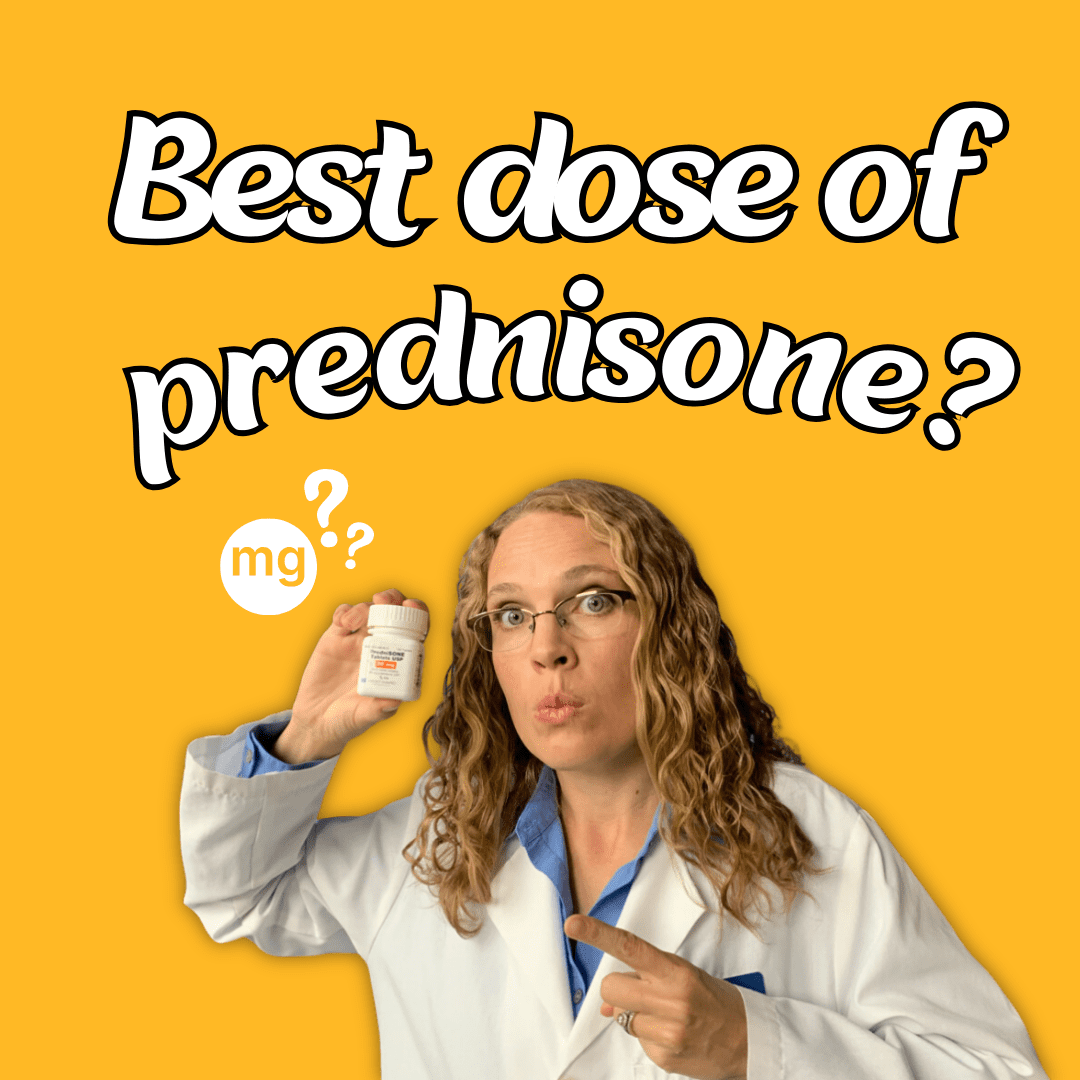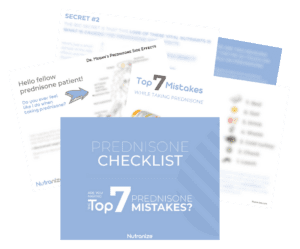What is the Best Dose of Prednisone?

People often want to know if their dose of prednisone is the best one.
They may want to know if it should be higher or lower.
In this article, find out what’s the best dose of prednisone.
Watch now!
Finding the Optimal Dose of Prednisone
When it comes to managing certain medical conditions, prednisone has proven to be a highly effective medication. However, determining the best dosage of prednisone can be a complex task, as it varies depending on the condition being treated, individual patient factors, and desired treatment outcomes.
What is Prednisone?
Prednisone is a synthetic corticosteroid widely used for its potent anti-inflammatory and immunosuppressive properties. It is commonly prescribed for a range of conditions, including allergies, asthma, rheumatoid arthritis, autoimmune disorders, and certain cancers. The dosage of prednisone plays a vital role in managing these conditions effectively while minimizing potential side effects.
Factors Influencing Prednisone Dosage
Medical Condition
The condition being treated significantly influences the prednisone dosage. Each condition may require a different therapeutic approach, and the dose should be tailored accordingly to achieve the desired treatment outcomes.
Severity of Symptoms
The severity of symptoms experienced by the patient can impact the initial dosage of prednisone. Higher doses may be necessary for severe symptoms, while lower doses can be effective for milder cases.
Individual Patient Factors
Various patient-specific factors like age, weight, overall health, medical history, and response to previous treatments must be considered. These factors can help physicians determine the appropriate dosage, ensuring it is safe and effective for the individual patient.
Treatment Duration
The duration of prednisone treatment is crucial in determining the dosage. Short-term treatments generally involve higher doses, while long-term treatments require careful tapering to minimize potential withdrawal symptoms.
What are the Side Effects of Prednisone you might experience?
- Increased Appetite and Weight Gain: Prednisone can stimulate appetite, leading to increased food intake and weight gain. This side effect is more pronounced with long-term use and higher doses.
- Fluid Retention: Prednisone can cause fluid retention and bloating, leading to swelling in the face, hands, and feet. It is important to monitor fluid intake and consult with a healthcare provider if excessive swelling occurs.
- Mood Swings and Emotional Changes: Prednisone can affect mood and behavior, leading to mood swings, irritability, and anxiety. Some individuals may experience changes in sleep patterns and difficulty concentrating.
- Increased Susceptibility to Infections: Prednisone suppresses the immune system, making individuals more susceptible to infections. It is important to take precautions to avoid exposure to contagious illnesses and promptly report any signs of infection to a healthcare provider.
- Osteoporosis and Bone Thinning: Prolonged use of prednisone can lead to bone loss, increasing the risk of osteoporosis and fractures. It is important to discuss strategies for protecting bone health, such as calcium and vitamin D supplementation, with a healthcare provider.
- Increased Blood Pressure and Blood Sugar Levels: Prednisone can cause an increase in blood pressure and blood sugar levels, especially in individuals with existing hypertension or diabetes. Regular monitoring of blood pressure and blood sugar levels is crucial.
- Adrenal Suppression: Long-term use of prednisone can suppress the adrenal glands, which produce natural corticosteroids. Abruptly stopping prednisone after long-term use can lead to adrenal insufficiency, characterized by fatigue, weakness, and low blood pressure. Tapering off prednisone under medical supervision is essential to allow the adrenal glands to gradually resume proper function.
Here are some of the prednisone side effects I personally experienced:

It is important to note that not all individuals will experience these side effects, and the severity of side effects can vary. Healthcare providers carefully weigh the potential benefits of prednisone treatment against the risks of side effects when determining the optimal dosage. Open communication will ensure that the benefits of prednisone outweigh the risks in your specific case.
Finding the Optimal Prednisone Dose
Consultation with Healthcare Provider
The first step in determining the best prednisone dosage is to consult with a qualified healthcare provider. They will evaluate your medical condition, assess your symptoms, and consider individual patient factors to determine the optimal dose for you.
Start Low and Gradually Increase
It is common practice to start with a low dosage of prednisone and gradually increase as necessary. This approach allows for monitoring treatment effectiveness while minimizing potential side effects. It also helps find the lowest effective dosage to manage symptoms, reducing the risk of long-term complications.
Regular Monitoring and Adjustments
Throughout the treatment, regular monitoring of symptoms, blood tests, and check-ups are essential. This allows healthcare providers to assess the effectiveness of the current prednisone dosage and make adjustments if needed.
Tapering Off
When discontinuing prednisone after long-term use, it is crucial to gradually taper the dosage under medical supervision. Abruptly stopping prednisone can lead to adrenal insufficiency and withdrawal symptoms. Tapering off allows the body’s natural corticosteroid production to gradually resume.
The Importance of Tapering off Prednisone
The tapering process involves gradually decreasing the dosage of prednisone over a period of time, under the guidance and supervision of a healthcare provider. The duration of the tapering process depends on various factors, such as the length of time the person has been on prednisone and the dosage they were taking.
The rate of tapering is usually slow and tailored to the individual’s specific needs, aiming to strike a balance between allowing the adrenal glands to reawaken and minimizing the risk of relapse or withdrawal symptoms. The healthcare provider will monitor the individual closely during this process to ensure that the tapering is proceeding smoothly and to address any adverse effects that may arise.
It is important to note that tapering off prednisone should always be done under medical supervision. Attempting to abruptly stop or reduce the dosage without proper guidance can be dangerous and increase the risk of adrenal insufficiency or other complications.
By tapering off prednisone gradually, individuals can give their bodies the time and support needed to safely transition from synthetic corticosteroids to the normal function of the adrenal glands. This helps minimize the risk of withdrawal symptoms and allows for a smoother recovery process.

Prednisone Taper Chart
Receive a free Prednisone Taper Chart to help you know when to taper down in prednisone dose. This does not substitute your doctor’s prescription.
Introducing Nutranize Zone for Prednisone
Nutranize Zone is the first and only supplement for people on prednisone. It’s specifically designed to counteract the side effects prednisone is causing.
It packs all the essential nutrients you need to combat Prednisone’s side effects into a single carefully formulated supplement. These nutrients promote better sleep, bone health maintenance, blood sugar level stabilization, and support your overall well-being. Whether you’re actively using Prednisone or are in the tapering stage, we guarantee that Nutranize will help you feel better than you can imagine.
Ingredients of Nutranize Zone
Nutranize Zone only uses simple and natural pharmaceutical-grade ingredients, all backed by clinical evidence, specifically formulated to replenish all the nutrients depleted by Prednisone. The following 9 ingredients are contained in both the morning and bedtime bottle, and each plays an essential role in counteracting Prednisone’s side effects:
- Vitamin A: Important for supporting normal vision and strengthening the body’s immune system.
- Vitamin C: Contributes to the immune system’s defense and helps to lower blood sugar.
- Vitamin D: Aids in bone health by helping the body absorb and retain calcium while helping the immune system fight bacteria and viruses.
- B Vitamins & Folate: (Thiamin, Riboflavin, Niacin, Vitamin B6) Maintains proper cholesterol balance, boosts metabolism, and supports healthy mood, red blood cell formation, eye health, and cell division.
- Calcium: Aids in bone health/strength and regulates blood pressure and body weight
- Magnesium: Aids in gut & bone health, helps regulate blood sugar, and promotes a steady, healthy heart rate.
- Chromium: Helps to lower blood sugar and regulate a healthy body weight.
- Potassium: Helps the body decrease blood pressure.
- Cassia Bark (Cinnamon): Helps the body lower blood sugar levels.
- Zinc: Helps the immune system function, soothes the digestive system, supports skin health, and is essential for thyroid help.
- Berberine: Helps the body lower blood sugar, reduce weight, and maintain proper cholesterol balance.
- Vitamin K: Essential for proper bone health and helps the body utilize the calcium and vitamin D already present in Nutranize Zone.
- Melatonin: Regulates the sleep-wake cycle to help promote sleep in the evening. (A melatonin-free version can be provided upon request)
Replenish Your Body, Regain Your Life – The Ultimate Support for Prednisone Users
Related Posts
-
How Long Can You Take Prednisone Safely?
I know that struggle between “It’s helping, but how long can I be on Prednisone... -
How to Taper Prednisone – Printable Taper Chart
How to Taper Prednisone In this article, I explain how to taper prednisone to prevent... -
7+ Things To Avoid While Taking Prednisone
Are you wondering what to avoid while taking prednisone? When I took prednisone, I wanted...


